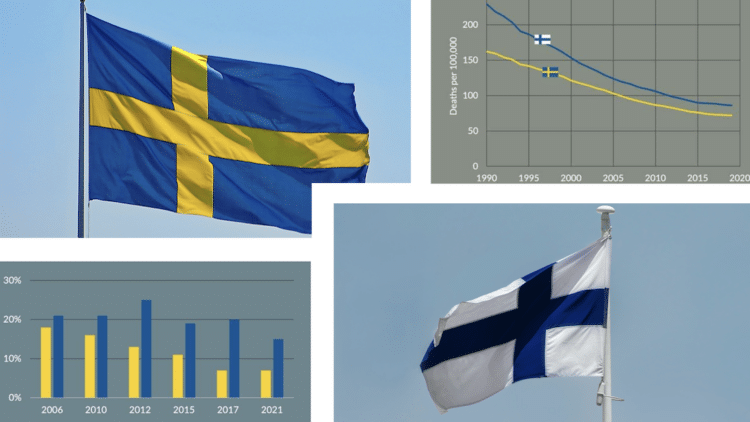
Sweden vs. Finland: Snus, tobacco control, and public health
Finland consistently outranks Sweden when it comes to tobacco control. But does Finland’s higher ranking translate into public health gains? Snusforumet takes a closer look.
Sweden and Finland share a long and complicated history as Nordic neighbours separated by the Baltic Sea. In some matters, the body of water jutting up between the two countries feels like nothing more than an easily-crossed stream. In other matters, it’s more like an ocean.
For roughly 700 years, much of modern-day Finland was ruled by Swedish kings until Russia took control of the territory in 1809. Coincidentally, this was right around the time snus was gaining in popularity among farmers and labourers in the region. Despite falling under Russian control, Finland’s and Finns’ ties to Sweden remained strong, with both the Swedish language and snus consumption remaining strong compared to other countries in the region.
The countries’ special relationship continued following Finnish independence in 1917. It’s no accident that both countries decided to join the EU and NATO together.
While both Finland and Sweden became EU member states together in 1995, Swedes’ affinity for snus prompted the government to negotiate an exemption to the EU’s 1992 snus ban as a condition of joining.
Since then, Finns have only been able to get their hands on snus by crossing the Swedish border in the north, or purchasing it on international waters aboard one of the popular ferry boats that shuttle passengers across the Baltic.
Finland’s EU-mandated snus ban may have complicated life for Finnish snus consumers, but it has also provided a live experiment for examining the relationship between restrictive tobacco regulations and public health.
Tobacco Control Scale: Finland beats Sweden
Since 2010, Finland has ranked higher than Sweden on the Tobacco Control Scale, a partially EU-funded initiative that aims to systematically measure and track tobacco control efforts across Europe.
In the most recent edition of the ranking, published in late 2022, Finland landed in seventh place, while Sweden had fallen to spot 25, down from 16 in the previous ranking.
Finland’s high ranking means the country is considered to have much stronger and more effective tobacco control measures in place compared to Sweden.
Assuming that the primary aim of tobacco control measures is to minimise smoking and its negative health and societal impacts, it should follow that Finland also has a lower smoking prevalence than Sweden and score better when it comes to tobacco-related health outcomes.
In other words, a lower percentage of Finns should still smoke, and the country should have lower rates of lung cancer and other tobacco-related diseases corresponding with Finland’s higher tobacco control rating.
However, the numbers tell a different story – especially when looking at populations that consume snus.
Current Smokers: Sweden beats Finland
Despite far outranking Sweden on the Tobacco Control Scale, Finland still has a higher percentage of smokers than Sweden. Eurobarometer data shows that more than twice as many Finns (15 percent) currently smoke compared to Swedes (7 percent).
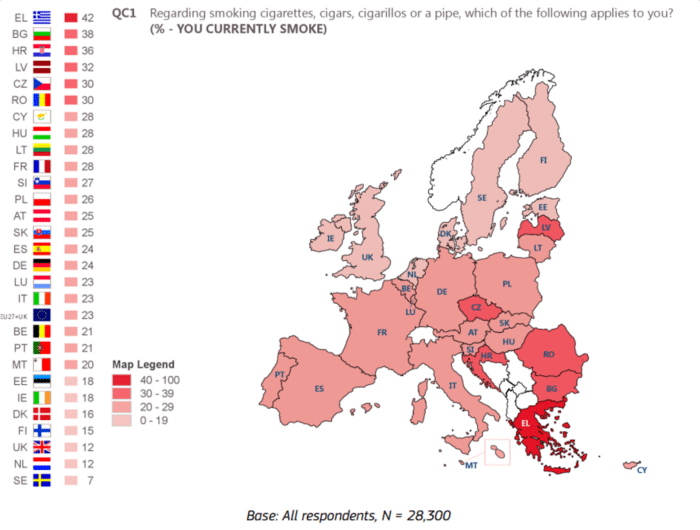
Looking at historical Eurobarometer data, Sweden has consistently had fewer current smokers than Finland. While the percentage of Swedes who smoked dropped year after year, Finland’s smoking rate actually increased between 2010 and 2012.
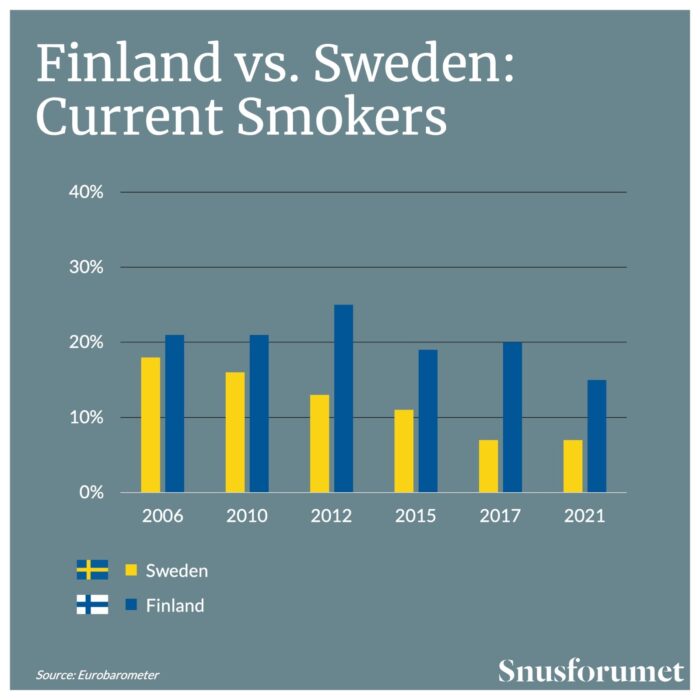
Only in the most recent data has Finland achieved an appreciable drop below 20 percent. But Finland still has a higher percentage of current smokers today than Sweden did more than a decade ago – despite its high ranking in the Tobacco Control Scale.
Smoking Prevalence – Gender: Sweden beats Finland
Looking further back and isolating smoking prevalence according to gender further demonstrates that Finland has lagged behind Sweden in reducing smoking rates for the better part of the last three decades.
In 1980, smoking prevalence among Swedish and Finnish men was about the same. While smoking among men has fallen in both countries, the drop is substantially steeper in Sweden. The gap widened after 1995 when both countries joined the EU and Sweden managed to maintain its exemption from the EU snus ban.
Since 2010, the gap has closed slightly, but smoking prevalence among Swedish men remains about half that of Finnish men.
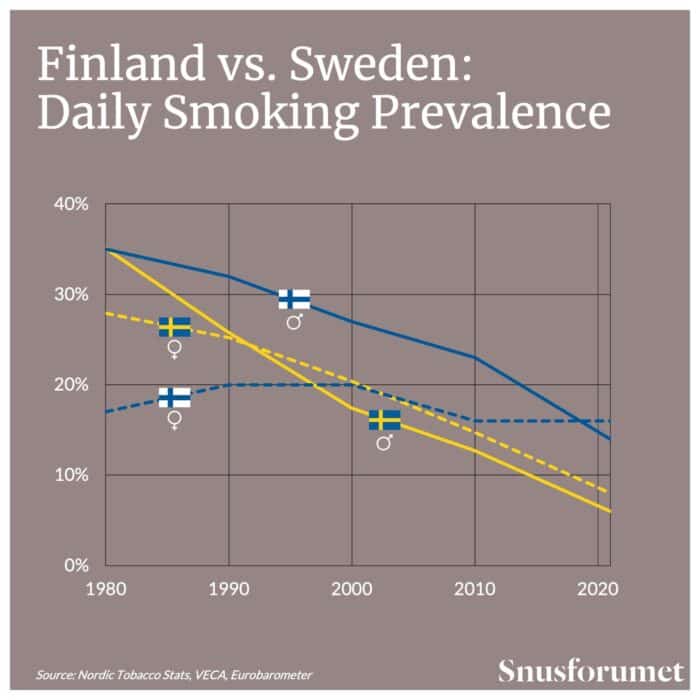
Comparing smoking among women in Finland and Sweden, one sees that rates have been falling steadily among Swedish women since the 1980s. In Finland, meanwhile, around 20 percent of women smoked until 2000. Rates dropped at roughly the same pace in the decade that followed.
But from 2010 until today, smoking among Finnish women has stopped falling, stabilising at around 16 percent. In Sweden, meanwhile, smoking among women has dropped steeply to around 8 percent.
While the paths have varied slightly, it’s clear that smoking prevalence among both men and women in Sweden is roughly half what it is in Finland, even though Sweden supposedly performs “worse” when it comes to tobacco control.
Tobacco-related Mortality – Men: Sweden beats Finland
At the end of the day, efforts to get people to stop smoking are motivated by a desire to prove public health and prevent as many early deaths as possible. Comparing Sweden and Finland when it comes to tobacco-related mortality reveals how Sweden’s longer and stronger tradition of snus gave the country a sizeable headstart in reducing smoking-related deaths.
In 1990, smoking-related diseases like lung cancer and COPD claimed 229 lives per 100,000 men, compared with only 160 in Sweden. At the time, the smoking rate among men in Finland was 32 percent, compared with only 25 percent in Sweden.
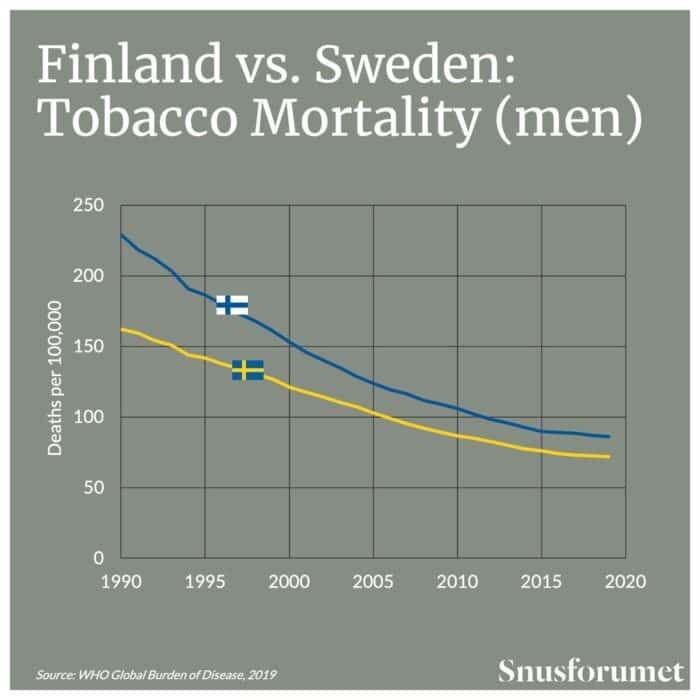
Since then, tobacco-related mortality has fallen in both countries, and Finland has managed to close the gap. However, Sweden maintains an advantage according to figures from the most recent Global Burden of Disease study.
Conclusion: Sweden beats Finland thanks to snus
Finland may have beaten Sweden to the prize of NATO membership and rank above Sweden as the world’s happiest country. But when it comes to reducing smoking rates and reaping the public health benefits that follow, Sweden – thanks in large part to snus – has a clear edge on Finland, despite what the Tobacco Control Scale may say.




